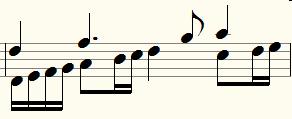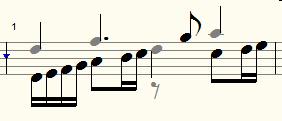Polyphony: Difference between revisions
No edit summary |
No edit summary |
||
| (3 intermediate revisions by the same user not shown) | |||
| Line 1: | Line 1: | ||
If you want to notate '''polyphonic music''' on a single stave you will have to realize how [[music notation]] handles it... | |||
In music notation, you'll need to make it perfectly clear when a note begins and ends. For monophonic music, that's easy; all notes are one after the other, only when the note (or rest) is over does the next one begin. If straightforward polyphony is notated by adding extra balls to the stems, the beginning and end of the notes don't change that much, they just go along with the note they are attached to ([[secondary note]]s in MusiCAD). | |||
It becomes more complicated if the following notes have a different duration or if really polyphonic (more independent parts) have to be written in a bar. | |||
The strategy to use is always: | |||
:first find the 'path' over the shortest note duration in the measure, | |||
:hang longer notes on an existing stem (or rest), | |||
:then 'release' the note from the stick with {{key|'}} | |||
[[File:polyfonie.jpg|polyphony]] | |||
The shortest-duration path in the measure above runs almost entirely over the lower part. Halfway through the third beat you need a trick to write things down: an eighth rest with a quarter note as a follow. | |||
[[File:polyfonie-2.jpg|polyfonie-2.jpg]] | |||
More complicated polyphony will be easier to note by using two separate parts and displaying them in 1 bar. | |||
==See also== | |||
* [[examples_-_piano|Examples piano]] | |||
[[nl:Polyfonie]] | [[nl:Polyfonie]] | ||
Latest revision as of 14:31, 23 June 2023
If you want to notate polyphonic music on a single stave you will have to realize how music notation handles it...
In music notation, you'll need to make it perfectly clear when a note begins and ends. For monophonic music, that's easy; all notes are one after the other, only when the note (or rest) is over does the next one begin. If straightforward polyphony is notated by adding extra balls to the stems, the beginning and end of the notes don't change that much, they just go along with the note they are attached to (secondary notes in MusiCAD).
It becomes more complicated if the following notes have a different duration or if really polyphonic (more independent parts) have to be written in a bar.
The strategy to use is always:
- first find the 'path' over the shortest note duration in the measure,
- hang longer notes on an existing stem (or rest),
- then 'release' the note from the stick with <'>
The shortest-duration path in the measure above runs almost entirely over the lower part. Halfway through the third beat you need a trick to write things down: an eighth rest with a quarter note as a follow.
More complicated polyphony will be easier to note by using two separate parts and displaying them in 1 bar.


